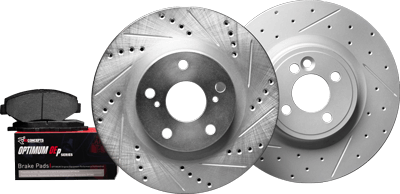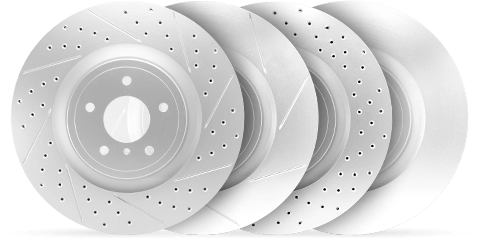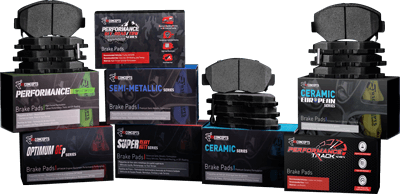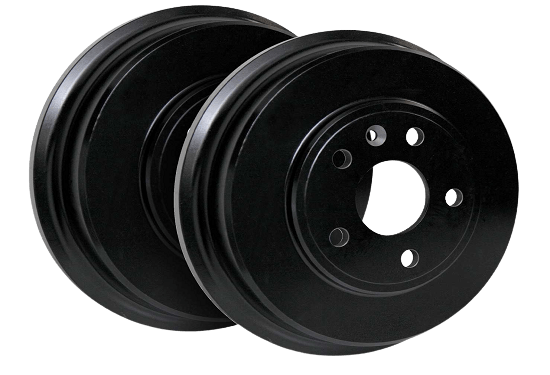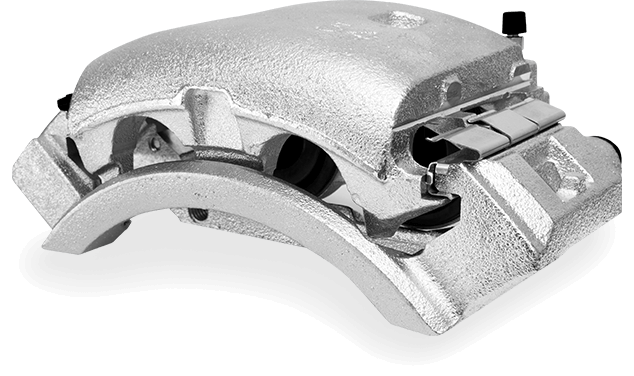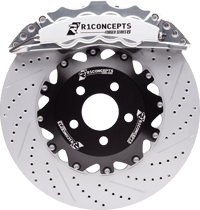
When it’s time to replace the brake pads on your Honda CR-V, it’s essential to understand the different types of pads available: ceramic, semi-metallic, and high friction. Each is designed to match varying driving preferences for your Honda CR V so you can select the best option that aligns with your driving needs.
Key Takeaways
Ceramic brake pads: the stealthy ninjas of the brake world—quiet, clean, and durable but not great in the cold!
Semi-metallic pads are the life of the stopping party, packing a punch in performance but making your wheels a bit dustier.
High friction formulation pads: perfect for emergency stops but brace yourself for some serious rotor wear and road noise.
Ceramic Brake Pads

Ceramic brake pads for Honda CR-V are known for being very quiet. They don’t make much noise, which is great for a peaceful drive. They also produce little brake dust, keeping your wheels cleaner for longer.
These pads are durable and can last longer than semi-metallic and OEM pads. They handle heat well, which helps them last even longer and prevents problems like overheating or rotor damage during heavy braking.
However, in cold weather, ceramic brake pads might not grip as well initially compared to semi-metallic pads. Despite this, Honda CR-V owners and others looking for reliable brakes will find ceramic pads to be a good choice for everyday driving due to their quiet operation, reduced rotor wear, and long lifespan.
Semi-Metallic Brake Pads

For those who want stronger brakes, semi-metallic brake pads for Honda CR-V are a great choice. They are made of 30% to 65% metal, making them durable and good at stopping. They work well in tough conditions like salt and water.
Semi-metallic pads are especially good in cold weather. Unlike ceramic pads, they don’t need to warm up to work well. They also cool down quickly, making them good for heavy driving.
However, they are noisier and create more dust. This means you might need to clean your wheels more often. They can also wear down the brake rotors faster. If you want strong and durable brakes, semi-metallic pads are a strong option.
High Friction Formulation Brake Pads

Brake pads for Honda CR-V with a high friction formulation are designed to provide excellent stopping power. For drivers who frequently encounter sudden stops, these brake pads can be crucial for safety. They disperse heat well and resist brake fade, maintaining performance even in tough conditions. Whether in hot summers or cold winters, these pads are reliable.
However, the high friction can cause faster rotor wear, and sometimes more pressure is needed to achieve the same stopping force as semi-metallic pads. Despite this, for those who prioritize strong stopping power, high friction formulation brake pads are a top choice.
Comparing Brake Pad Types
Selecting the right brake pads from ceramic, semi-metallic, and high friction formulations is like choosing your favorite child—each has unique benefits. Aftermarket brake pads can sometimes be better than OEM pads in tough conditions. But what should you consider?
Noise is important. Ceramic pads are very quiet, perfect for everyday driving. Semi-metallic pads are louder but stop better and last longer. High friction pads stop best but are the noisiest.
Think about dust and rotor life. Ceramic pads make less dust and are gentle on rotors, so they last longer. Semi-metallic and high friction pads make more dust and wear out rotors faster. Choose based on what matters most to you: performance, quietness, or less dust.
Choosing the Right Brake Pads for Your Driving Style
The type of brake pads you choose depends on how you drive. If you want a quiet ride and long-lasting pads, go for ceramic brake pads. They work well for long highway trips and keep performing without fading.
If you drive aggressively, go through mountains, or carry heavy loads, semi-metallic brake pads are better. They handle heat well and provide strong braking.
Choosing the right brake pads for your driving style improves your vehicle’s performance and safety. It also makes driving more comfortable and gives you better control.
Aftermarket vs OEM Brake Pads
Car enthusiasts often find it challenging to choose between OEM and aftermarket brake pads. OEM pads come with warranties that guarantee their performance and longevity. They are designed to fit specific car models, ensuring quiet braking.
On the other hand, brands like R1 Concepts offer aftermarket options that can match or exceed OEM performance. They are usually cheaper but you need to check warranty details and compatibility with your vehicle.
Choosing between OEM and aftermarket brake pads depends on what you value more—reliability and exact fitment or cost savings and performance. Consider your driving needs and conditions before making a decision.
When to Replace Your Brake Pads
Understanding the appropriate time to replace your brake pads is crucial for upholding both the safety and performance of your vehicle. If you start hearing squeaking or grinding noises, or feel vibrations when applying the brakes on your Honda CR-V, these may be indicators that it’s time to inspect your brake pads.
By performing a visual examination, you can typically detect whether there’s significant wear. If any pad measures less than 14 inch thick, it should be replaced immediately. Neglecting these warning signs can lead not only to total depletion of the brake pads but also inflict harm on other components within the braking system like rotors – avoid this by following replacement schedules as outlined in your owner’s manual.
To prevent extensive repair costs and maintain optimal safety in driving conditions with regard to your Honda CR-V, routine checks on brake pads are advised along with timely replacements based upon their condition. It’s equally important not to overlook an illuminated brake pad indicator light on the dashboard, which signals attention is required for proper maintenance of brakes.
DIY vs Professional Brake Pad Replacement
Undertaking the task of replacing your brake pads can lead to significant savings, potentially keeping hundreds in your pocket versus paying for a mechanic’s services. With fundamental mechanical knowledge and essential tools like gloves, jack, lug wrench, and C-clamp at hand, you are well-prepared to do it yourself. It is wise to focus on changing the pads on one side first before moving onto the other in order to maintain alignment and easier access.
It’s important during pad replacement to keep an eye on brake fluid levels as pushing back the brake pistons could cause spillage or overflow if not monitored closely. Ensuring careful handling of the brake fluid is critical as mistakes here can be costly.
For those valuing convenience over hands-on work or who don’t feel up for a home-based job, turning towards professional assistance is always advisable. Opting for expert service guarantees that the brakes are fixed correctly while also providing assurance against possible errors occurring from personal endeavors in DIY repair projects with regards to the replacement of brake components including pads.
Cost of Replacing Brake Pads
The price of brake pad replacement can fluctuate due to various elements. For example, the OEM pads for a Honda CR-V have an MSRP of $82.65 for the rear set and $87.65 for the front set. The final cost may also depend on which brake pad set you select and how much labor charges are.
You could potentially save money by choosing an aftermarket disc brake pad set without sacrificing quality or performance compared to OEM pads. An alternative rear brake pad option is available at just $58.52, providing a more economical solution than factory-supplied parts for your Honda CR-V.
To maintain control over your vehicle maintenance expenses efficiently, it’s important to be informed about these prices and seek out the best deals possible when replacing brakes or other car parts. Regardless if you go with OEM or third-party pads, ensuring that you’re receiving excellent value should be a top priority in managing costs effectively.
Summary
Ensuring you select the appropriate brake pads for your Honda CR-V is crucial to maintaining superior braking performance, safety measures, and long-term durability. This guide has examined the advantages and disadvantages of ceramic pads known for their quiet operation with minimal dust production, semi-metallic pads that offer substantial stopping power, and high friction formulation pads designed to maximize friction.
It’s vital to align your choice of brake pad material—whether it be ceramic or semi-metallic—with your specific driving habits and conditions. Matching the right type of pad with the exact year of manufacture for your Honda CR-V will guarantee both compatibility and optimal performance levels.
When weighing options between OEM (original equipment manufacturer) brake pads versus those available on the aftermarket scene remember each comes with its own set of merits. Keeping well-informed about these choices can help ensure peak functioning from your Honda’s brakes as well as provide a safer and more enjoyable journey while navigating in your CR-V.
Frequently Asked Questions
What are the benefits of ceramic brake pads for my Honda CR-V?
Switching to ceramic brake pads for your Honda CR-V means enjoying a smoother ride with less noise and brake dust—it’s like giving your wheels a spa day!
Plus, they’ll outlast those pesky alternatives while keeping your rotors happy.
How do semi-metallic brake pads perform in cold weather?
Semi-metallic brake pads are like that friend who shows up ready to party—no warm-up required, even in the cold! They handle aggressive driving and tough conditions with ease, keeping your stopping power on point.
When should I replace my Honda CR-V’s brake pads?
If your Honda CR-V starts sounding like a rusty door or vibrates like it’s auditioning for a dance show, it’s time for new brake pads.
Keep an eye out for pads thinner than 14 inch or that pesky brake pad indicator light—these are your clear ‘replace me’ signs!
Are aftermarket brake pads as good as OEM pads?
Absolutely, aftermarket brake pads can be just as good, if not better, than OEM pads—especially if you go for reputable brands like R1 Concepts.
Just remember to confirm compatibility and warranty before you hit the brakes!
Can I replace my brake pads myself, or should I see a professional?
Absolutely, if you’ve got some mechanical chops and the right tools, you can swap those brake pads yourself—just remember, confidence is key!
But if you’re feeling a bit shaky, calling in a pro is like inviting a superhero to save the day.


